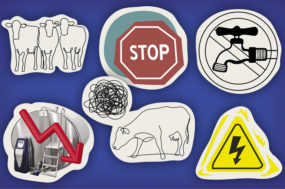“Invited review: Iodine level in dairy products – A feed-to-fork overview.” Journal of Dairy Science Vol. 106 No.4, 2023. This invited review, from Italian and Swiss researchers, aims at providing an overview on the mechanisms that contribute to the iodine concentration of milk and dairy products. The authors say that iodine plays a fundamental role in animal nutrition and physiology, and in cattle it is an essential micronutrient during lactation and for fetal development and the calf’s growth. Iodine is one of the trace elements of milk and, in addition to iodized salt and seafood, milk and dairy products are the main source of iodine in the human diet. Iodine is fundamental to maintain the functionality of the thyroid gland and to sustain physiologic and metabolic processes regulated by thyroid hormones.
Iodine level in milk is affected by numerous factors along the entire dairy food chain. The main driver is the level of iodine in the feed administered to lactating animals, which has been demonstrated to be linearly associated with the final milk iodine concentration. Such a relationship is well documented in literature. The adoption of iodized teat sanitizers has been identified as a further factor able to increase milk iodine concentration. This happens due to the presence of disinfectant in the teat canal after post-dipping and to the local absorption of iodine at the epithelial level, followed by a release of this mineral into the secreted milk. The scientific literature demonstrates that milk iodine concentration also has a genetic component in cattle, meaning that there is genetic variability for this trait as the populations diverge in terms of estimated breeding value for milk iodine concentration. Still, milk iodine concentration has very little heritability.
Iodine content of feed ingredients reflects the passive uptake of crops and vegetables from soil and water. This, however, is generally not sufficient to cover the adequate intake of a dairy cow, and inclusion of iodine supplements in the diet is fundamental to fulfill the adequate intake and support body maintenance, milk production and fetal development. In cattle, the main site of absorption of this element is the rumen, from where it is transported in the organism through specific binding with plasma proteins. Other than visible goiter formation, clinical signs of deficit include silent estrus, low first-service conception rate and stillbirths, all associated with sub-physiological T4 concentrations in blood. (T4 is a thyroid hormone called thyroxine.)
In terms of human health studies, the authors indicate that the recommended daily iodine intake in adult women and men has been established at 150 μg per day. Considering the minimum and maximum milk iodine level retrieved from literature, a glass of milk (125 mL) can provide from 11 to 61 μg of iodine, which translates into 7% to 41% of the recommended daily intake of adults, respectively. Iodine can be obtained exclusively through the diet or through iodine supplements and cannot be replaced by any other nutrient. Fewer data are available for commercial dairy products other than milk, but much higher iodine concentrations were measured in cow whey cheeses and goat whey cheeses. High iodine concentrations were also obtained for different kinds of whey protein isolates and concentrates. Such results suggest that iodine is likely embedded in whey proteins, but the authors say that specific and dedicated studies are recommended to confirm this speculation.
The article indicates statistics showing that since the 1990s, great improvements have been made in the elimination of iodine deficiency-related diseases: According to World Health Organization (WHO) data, the number of iodine-deficient countries decreased by half, from 110 countries in 1993 to 54 in 2003. From 2003 to 2017, the number of iodine-deficient countries in the world further fell by 64.8%, from 54 countries to 19. Although data demonstrate that improvements were achieved through specific campaigns in the past decades, it is still a long road to reach iodine adequacy and iodized salt coverage, even in developed countries and particularly in childbearing-age women. In numerous published reports, dairy products have demonstrated a significant role in contributing to the total iodine intake, especially in children. The authors expect milk iodine to remain an important topic in the future that deserves consumer education and attention in food science through scientific research and economic funding.
“Invited review: Selective use of antimicrobials in dairy cattle at drying-off.” Journal of Dairy Science Vol. 105 No. 9, 2022. This review, from researchers from several parts of the world, including Canada, summarizes available literature regarding current dry cow therapy practices and associated impacts of selective dry cow therapy on udder health, milk production, economics, antimicrobial use and antimicrobial resistance. The authors say that administering intramammary antimicrobials to all mammary quarters of dairy cows at drying-off (i.e., blanket dry cow therapy) has been a mainstay of mastitis prevention and control. However, as udder health has considerably improved over recent decades with reductions in intramammary infection prevalence at drying-off and the introduction of teat sealants, blanket dry cow therapy may no longer be necessary on all dairy farms, thereby supporting antimicrobial stewardship efforts. They refer to the example of the Netherlands where, since the introduction of a mandatory ban on blanket dry cow therapy, dry cow therapy antimicrobial use has declined by 36% and overall intramammary antimicrobial use (including treatments during lactation) has declined by 15% between 2013 and 2017.
The authors indicate that intramammary (IMM) administration of antimicrobials to all quarters of all dairy cows at drying-off is a key component of the National Mastitis Council Recommended Mastitis 10-point Control Program. The majority of antimicrobial use on dairy farms is for mastitis treatment and prevention. A large proportion of producers have adopted blanket dry cow therapy, owing to the demonstrated efficacy of treating existing intramammary infections and mitigating the risk of new intramammary infection development, which is highest at the beginning of the dry period and at the start of the subsequent lactation.
In North America, blanket dry cow therapy is practiced on 80% and 84% of surveyed operations in the U.S. and Canada, respectively, whereas in Nordic European countries and the Netherlands, routine prophylactic antimicrobial use at drying-off is not permitted. Further, veterinary prophylactic antimicrobial use, other than in exceptional cases, has been forbidden in the European Union since Jan. 28, 2022. In all Nordic countries, cow or quarter bacteriologic diagnosis before dry cow therapy antimicrobial use is encouraged, or the herd mastitis pathogen profile and antimicrobial susceptibility profile should at least be known. In the Netherlands, veterinary guidelines for selection of cows eligible for antimicrobial dry cow therapy primarily based on SCC levels at drying-off were developed by the Royal Dutch Veterinary Association, although most farmers, in consultation with their veterinarian, use specific selection methods for their own herd. Selection criteria must optimize sensitivity and specificity for intramammary infection identification while remaining feasible, both logistically and financially.
The review recommends that before implementation of selective dry cow therapy, a review and optimization of herd and udder general hygiene and health characteristics should be undertaken, including bulk milk SCC thresholds, clinical mastitis incidence and factors that influence them, such as hygienic drying-off practices and mastitis pathogen profiles. It is important that major pathogen intramammary infection prevalence at drying-off and new major pathogen intramammary infection incidence in the dry period are minimized. Additional considerations include adequate record-keeping, so that producers know whether cows have had clinical mastitis during lactation or additional negative health consequences.
The review concludes that common themes emerged that present a positive argument in favour of selective dry cow therapy. Producers should be provided with selective dry cow therapy protocol options that reflect their access to data as the basis of antimicrobial treatment decision-making, as well as their motivation to choose one method over another. Further, sufficient evidence supports that teat sealants should be included as an integral part of a selective dry cow therapy protocol. Furthermore, ongoing producer and veterinary education is essential to increase antimicrobial stewardship in the dairy industry, and increased personal responsibility in antimicrobial reduction mitigation is required to promote the required behaviour change. In addition, proper evaluation mechanisms should be in place to evaluate impacts of introduced selective dry cow therapy protocols. In summary, selective dry cow therapy protocols can be enacted in countries with developed dairy industries without negative udder health and production impacts and will substantially reduce dry cow therapy-associated antimicrobial use, potentially reducing the impact on antimicrobial resistance.
References omitted but are available upon request. Click here to email an editor.
This column brings you information regarding some of the research being done around the world and published in the Journal of Dairy Science. The objective is to bring to light areas of research that may have an immediate practical application on a dairy farm, as well as research that, even though it may not have a practical impact now, could be interesting for its future potential application. The idea is to give a brief overview of select research studies but not go into detail on each topic. Those interested in further in-depth reading can use the citations to find each study.









